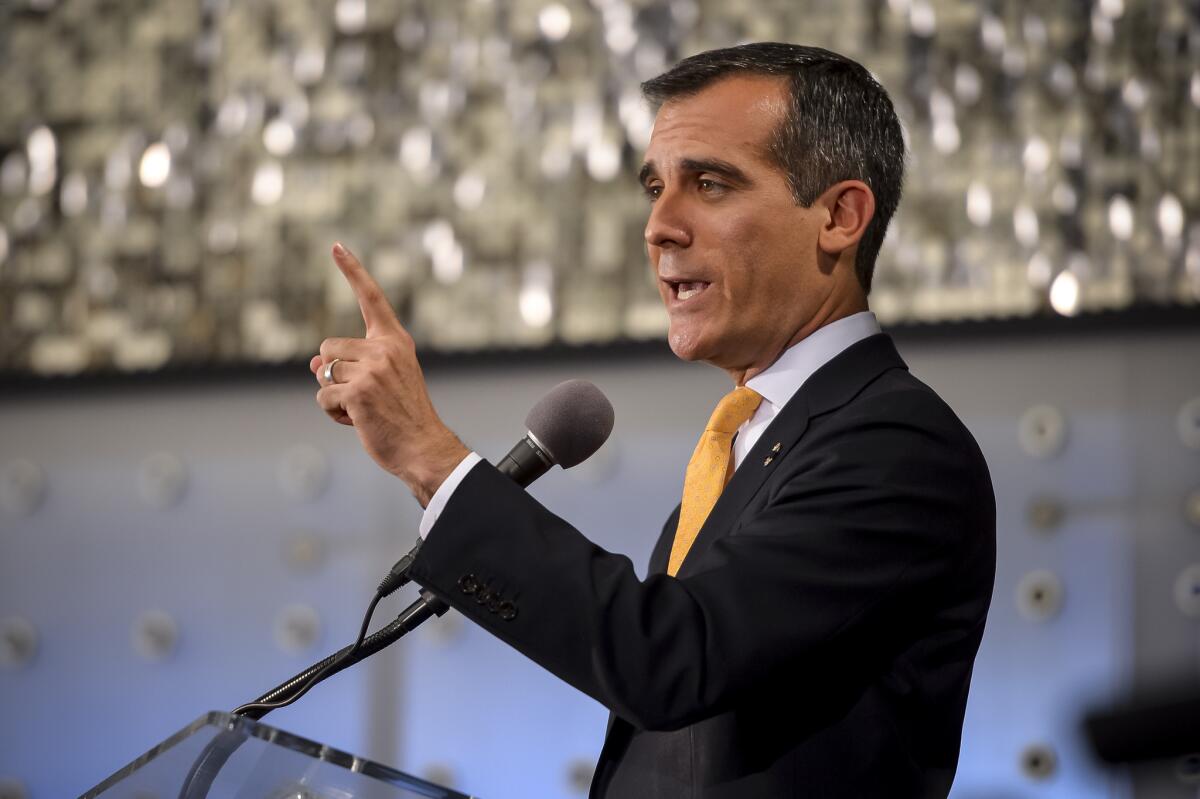L.A. lawmakers press for cleanup of city’s trash-strewn alleys

- Share via
When she was a child in South Los Angeles, 77-year-old Meredith Watts remembers she could play in the alleys. Now the dusty lane behind her 51st Street home is a perpetual nuisance, clogged with castaway armchairs, the husks of dead televisions, cans empty of hominy and mackerel.
“I’m the one that’s always calling,” Watts said, folding her arms over her bright pink T-shirt. Once a month or so, she phones the city’s Bureau of Sanitation to clear the urban flotsam that piles up behind her home.
“If you call, they’ll come out,” her longtime boyfriend Ernest Rice piped up from his seat on the porch. “But it just keeps coming.”
More than 900 miles of alleys stretch throughout Los Angeles, running thickest in South and Southeast L.A., according to a University of Southern California study six years ago. The pathways have long been a hub for trash and crime that only worsened after cutbacks in cleaning.
Now officials are poised to start spending more, with Mayor Eric Garcetti proposing $5 million to straighten up alleys, streets and vacant lots across the city. But leaders doubt that it will be enough to combat the seemingly nonstop piling of jettisoned furniture, stray tires and other debris, a menace that has become a major preoccupation for residents.
Los Angeles lawmakers are pressing for a systemic, citywide solution to replace the patchwork of smaller programs that have sprung up to meet the need. On Wednesday, the City Council directed sanitation officials to draw up a “data driven neighborhood cleanup program” to send crews to the areas most in need.
“Much in the way that … LAPD is able to move resources where crime is, we have to be able to move your resources where trash is,” Councilman Gil Cedillo told sanitation officials.
As it stands, “right now the system we have is, we scramble around in our own council districts” to provide such cleaning, Councilman Jose Huizar said.
Alleys used to be cleaned by the Bureau of Street Services, but money for the work was eliminated in recent years. The Bureau of Sanitation, in turn, has been responsible for picking up “bulky items” such as abandoned mattresses, whether left in alleys or elsewhere, but only when Angelenos make a phone call to alert the city.
After alley cleaning lost its regular funding, junk began to pile higher on curbs, in vacant lots and in the alleys that cut behind Los Angeles homes and businesses, according to city and community leaders. From their 51st Street porch, Watts and Rice lament that people drive by their alley at night to dump tires and unwanted furniture. Rice says a fire set in a homeless encampment there once burned part of the building next door.
“It degrades the area,” said Fernando Sarabia, a longtime resident and program coordinator for the El Santo Nino Community Center. “It seems like if one person sees that there’s dumping in the alley, another person goes and says, ‘I’ll dump it there too.’ It just keeps piling up.”
Politicians in some of the hardest hit areas have sought to tackle the problem themselves: Cedillo launched a pilot program with the Bureau of Sanitation in his Eastside district, clearing and maintaining 286 alleys, streets and lots as of April. The costs are expected to total $1.2 million by the end of the fiscal year in June.
In South L.A., Councilman Curren Price and his aides teamed up with a nonprofit to start cleaning at least two alleys a day in his district, allocating $550,000 in federal grant funds to the program this fiscal year. More than 1,100 tons of trash has been cleared, including one alley barbed with hundreds of hypodermic needles and scattered with cow skulls, Price said.
Other council members have had to dip into their discretionary office funds for cleanups, paying for what should be a routine city service, Councilman Felipe Fuentes said.
Alley cleanup happens “foot by foot, project by project, and often through a local sponsor who brings the project to the city and pushes for it,” said Travis Longcore, a USC associate professor of spatial sciences. But without a systemic approach, “the project that gets done may not always represent the biggest need.... This is where the city really does have a duty to give equal service across socioeconomic lines.”
City officials estimate that expanding the pilot program championed by Cedillo to cover the whole city would cost between $25 million and $30 million. With the budget still tight in the aftermath of the recession, Garcetti has recommended spending only a fraction of that sum.
The proposed $5 million would cover roughly eight weeks of cleaning for each council district, Garcetti spokeswoman Vicki Curry said. The sanitation bureau plans to create a “baseline” level of service that every district gets, along with a “variable” component that depends on need and demand, Curry said. An additional $3 million has been budgeted specifically to clean up skid row in downtown.
Getting any funding is a boon for the program. Still, Price and other city leaders worry that $5 million won’t be enough to keep alleys from filling with junk — an example of the financial challenges facing the mayor’s back-to-basics agenda.
If the city is worried about its basic “quality of life,” Price said, “picking up the trash has got to be at the top of that list.”
More to Read
Sign up for Essential California
The most important California stories and recommendations in your inbox every morning.
You may occasionally receive promotional content from the Los Angeles Times.














